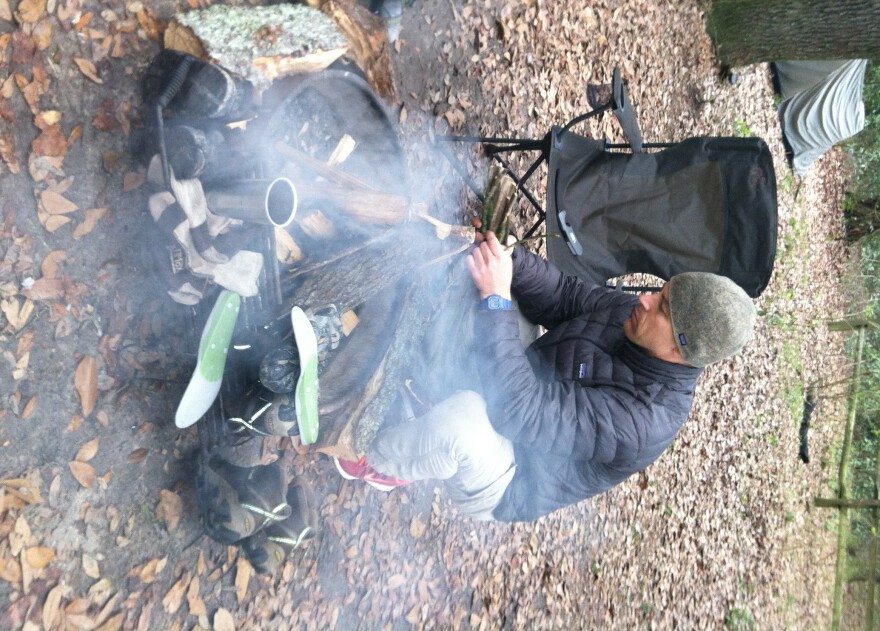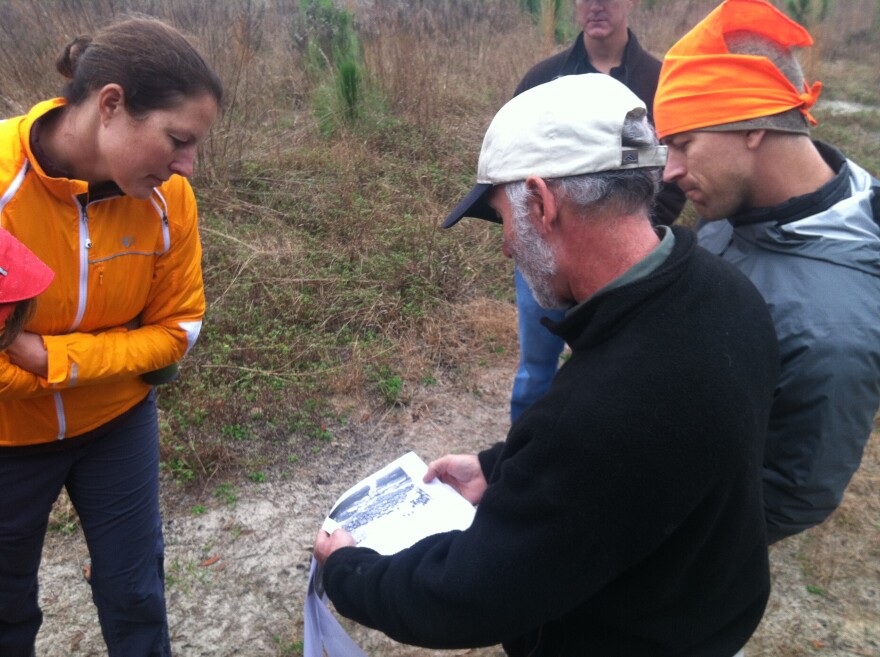Members of the Florida Wildlife Corridor Expedition are in the second week of their 10-week, 925-mile trek from Central Florida to the Alabama State line. Part of their trip goes through the Green Swamp. It's a mysterious place to most people, but critical to the the water supply for Central Florida.
It's a chilly morning at a remote campground in Pasco County, on the edge of the Green Swamp. Florida Wildlife Corridor Expedition member Joe Guthrie is busy chopping wood, trying to stay warm in the raw, damp cold. He's getting some heat from Zach Forsburg, who drives the support vehicle for the expedition.
"If you're going to lose a limb, lose it to a snake or an alligator," he says, "not chopping at camp."
The fire doubles as a sock and shoe dryer. And boy, did they need it.

"Well, there's a lot of wet trail walking. There are several different river crossings, and then just lots of the trail is flooded or has standing water," says expedition leader Mallory Lykes Dimmitt of Tampa.
She's huddling in her tent, while her shoes drip on the fire grate.
"So every day, we definitely got our socks and boots fully wet, and got the bottom of our legs pretty wet and just got used to wading through," she says."
The Green Swamp is just what its name is - more than a hundred thousand acres of protected wetlands and piney uplands that is a key link in the water supply for millions of people. It's the highest point in the Floridan Aquifer, the underground drinking source for a large chunk of the state. It's also the headwaters for four major rivers - the Hillsborough, Withlacoochee, Ocklawaha and the Peace River.
It's been described as the water tower for much of the state.
"It's truly a statewide influence for this aquifer, with rivers going to the Atlantic and the Gulf, and recharging the drinking water system that goes from Florida all the way to southern Georgia," says expedition veteran Carlton Ward Jr.
Ward says he was "really blown away by the beauty and expanse of this place."
"Yesterday, for example, I'm not sure we had a mental image of what we were going to encounter, but it was overcast and slightly drizzly, and we were right there by the Withlacoochee River by these cypress knees and swamps," says Ward. "It was absolutely breathtaking. Because of all the rains we had, the resurrection ferns were in full bloom and all the oak trees were just dancing and alive."
Thousands of people drive by it every day on Interstate 4, but not too many people know about the Green Swamp. It's a dark green blob on satellite photos, seemingly in a vise grip between the light gray of subdivisions encroaching on either side from Orlando and Tampa Bay.
And that means wildlife can get up close and personal to homes here.

On the way to the expedition from Dade City, I spot a wild turkey perched on the tool box of a pickup truck. The truck's owner is on speaking terms with the bird - he tries to feed it while his dog barks away.
Once I reach the campground, we take a three-hour, three-county tour of Green Swamp West, nearly 40,000 acres of land managed by the Southwest Florida Water Management District. August Fox, a senior land management specialist with the water district takes us on heavily rutted roads through Pasco, Sumter and Lake Counties, through cypress domes divided by higher ground. The district is replanting native longleaf pines. They once carpeted southeast Florida, but these trees were prized by log cutters, and only three percent remain.
Fox shows the group a photo of an old locomotive laden with logs from this area around a hundred years ago.
"If you remember that mainline grade up there, that was an original railroad tram. Some of these were the late 1800's, and up through the thirties," he says.
Dimmitt says none of the group knew what to expect here.

"The Green Swamp is so close, right here next to Tampa and Orlando, but not that well-visited by backpackers and recreationalists," she says. "So the Florida Trail is just an incredible resource right in our backyard, and we loved it. It goes through varied terrain, including pine flatwoods, palmettos, and then standing cypress swamps off to each side of the trail. So we actually waded out into the swamps, took some photographs, and just enjoyed it."
Ward, a Tampa photographer, points his camera at some of the longleaf pine being restored.
"I've enjoyed tremendously exploring this place the last three days. It's so close to home, but relatively unseen and undiscovered. To be able to hike the Florida National Scenic Trail and explore these rivers and creeks and uplands - it's a gem hiding in plain site.
With that, the group prepared to paddle down the Withlacoochee, one of the rivers born in this protected area.
This Saturday, the expedition will host a paddle on the Rainbow River in Dunnellon, open to the public. You can follow the expedition every week on WUSF.
- The expedition members recently were in the WUSF studios for a taping of Florida Matters. You can listen to it here.
- And you can revisit our coverage of the original 2012 expedition in our archives





